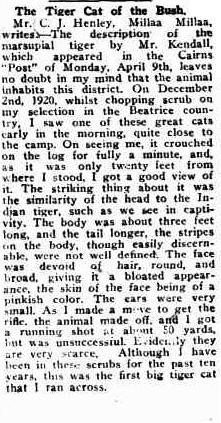“I would have had a photo of it, only for that they took it down the road to show it to the other timber cutters, and instead of bringing it back they threw it away on me and I never got a photo of it, cause I always carried a camera on me”
Harold West, Millaa Millaa, QLD – Interview about the striped Tiger – 2007
For Harold West of Millaa Millaa, Queensland, the native animals of the Maalan scrub were a common sight during the better part of 60 years working as a timber cutter. Lumholtz’s tree kangaroo were plentiful, as well as the many white-tailed rats that would chew your axe handle in the night. Green tree stakes, wompoo doves and a scrub python measuring 25 ft. in length were other memorable sightings from the area.

One night in the 1960’s while staying in the timber cutters camp, a chance encounter with a previously unseen animal hanging around the site would capture Harold’s interest. An audio excerpt from an interview with Harold in 2007 describes the encounter
Harold described his disappointment with the men not returning with the carcass of the animal which subsequently resulted in him not obtaining a photo of the animal the following day. We can debate the outcome of what a photo of the mythical striped tiger would have done for the animals recognition today, with currently no solid evidence of the animals existence ever recognised by the wider scientific community.
“I would have had a photo of it, only for that they took it down the road to show it to the other timber cutters, and instead of bringing it back they threw it away on me and I never got a photo of it, cause I always carried a camera on me“
Harold also provides a physical description of the animal in his own words.
Harold also recollects additional sightings of the animal from around the area by himself and fellow timber cutters.
“Down the Maalan, there seemed to be a lot down there. I never seen any up around Ravenshoe, when I was working out Koombooloomba.
Most of the time I noticed them down the Palmerston highway, I seen a couple down there cross the road.
Gordon Baker [fellow timber cutter] seen one down the bottom of his place where he lived at Middlebrook, down towards the Beatrice. [Beatrice River]
They’ve been around as people have seen them around here [Millaa Millaa] in the olden days.
What pushed them back a fair bit in the Maalan was the cutting of the scrub“
An additional sighting from the Millaa Millaa area appears in the Northern Herald in 1923 with description of an animal resembling that shot by Harold West. Additional sightings have also been reported around the Tolga area (Historical Account #13) as well is further south near Tully (Historical Account #16).

So what was the identity of these striped tigers? Some say they were surviving mainland thylacines, others suggest they were another species of carnivorous marsupial, possibly a thylacoleonid. I would like to debate the possibilities here further, but that will be saved for another post.
One thing does appear consistent with reports of these animals is that sightings were very rare, even in the early 1900s. Perhaps they were just barely surviving into modern times in these small pockets of rainforest in the wet tropics, already genetically doomed, with little chance of navigating the challenges rapidly approaching, such as the removal and segmentation of their natural ranges. One fact this is hard to ignore is that the reports of sightings are disappearing also, and that the memory of these animals will likely pass with those that were lucky enough to witness them in the twilight of their existence. Is there still hope that they may be clinging to existence in North Queensland? Does a 2017 article indicating investigations underway by James Cook University researches in Cape York (see article) provide a last change for the identification of these animals? We live in hope…
A special thanks to my mate Rod Simpson for the audio recording of this interview.